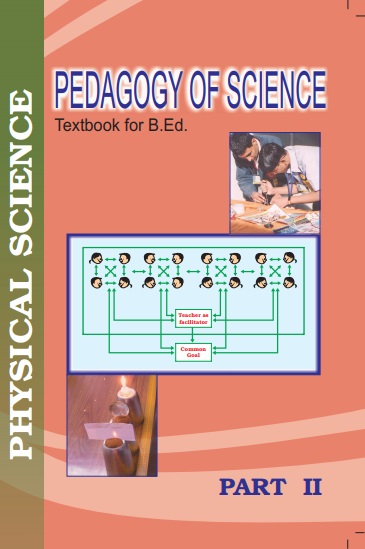Download Free NCERT e-Book "Pedagogy of Science: Physical Science Part-II - Textbook for B. Ed. Course"
Disclaimer: This website is NOT associated with CBSE, for official website of CBSE visit - www.cbse.gov.in

Download Free NCERT e-Book "Pedagogy of Science: Physical Science Part-II - Textbook for B. Ed. Course"
Contents:
PART II
10. Print and ICT Resources in Learning Physical Science 303
10.1 Introduction 304
10.2 Print resources 305
10.3 Dale’s cone of experience 311
10.4 Different forms of ICT and its application in science education 313
10.5 Using and selecting appropriate media 324
10.6 How ICT can cater to different learning needs of learners? 326
10.7 Skills to be developed in students in interconnected world 327
10.8 Social networking sites and their use in education 329
10.9 Integrating ICT in teaching learning process : An example 335
10.10 Summary 340
11. Tools and Techniques of Assessment for Learning Physical Science 342
11.1 Introduction 343
11.2 Test, examination, measurement, assessment and evaluation 344
11.3 Continuous and Comprehensive Evaluation (CCE) 346
11.4 Assessment framework 352
11.5 Assessment of learning of students with special needs 408
11.6 Summary 410
12. Planning for Teaching-learning of physical science 413
12.1 Why planning teaching-learning? 414
12.2 Planning: an example 415
12.3 Inquiring for planning lesson design 416
12.4 Identification and organisation of concepts 416
12.5 Elements of a physical science lesson 421
12.6 Making groups 431
12.7 Planning and organising activities in physical science 432
12.8 Planning laboratory work 438
12.9 Planning ICT applications 439
12.10 Reflective planning 441
12.11 Planning a unit 442
12.12 Lesson design: Examples 445
12.13 Summary 458
13. Lifelong learning in physical science 463
13.1 Introduction 464
13.2 Lifelong learning 464
13.3 Why lifelong learning 466
13.4 Attributes of lifelong learners 467
13.5 Developing lifelong learning attributes through teaching- learning of science 468
13.6 Every child has natural curiosity of observation and drawing conclusion 471
13.7 Students with special educational needs 472
13.8 Preparing learners for lifelong learning: Stimulating creativity and inventiveness in science 475
13.9 Effective use of ICT for lifelong learning 491
13.10 Teacher as lifelong learner 491
13.11 Summary 491
14. Professional Development of Physical Science Teachers 495
14.1 Introduction 496
14.2 Teaching as a profession 497
14.3 Need for pre-service professional development programmes 498
14.4 Need for in-service professional development programmes 503
14.5 Role of reflective practices in professional development 513
14.6 Summary 519
15. Teacher as a Researcher 521
15.1 Introduction 521
15.2 Action research vs. research 522
15.3 Selecting problem for action research 523
15.4 Format of a research plan 524
15.5 Knowledge is tentative 527
15.6 Action research in physical sciences 528
15.7 Areas of action research 529
15.8 Steps in action research 531
15.9 Helping students to develop attitude of research 538
15.10 Summary 539
Reference 541
Click Here to Download Full e-Book
Courtesy: NCERT